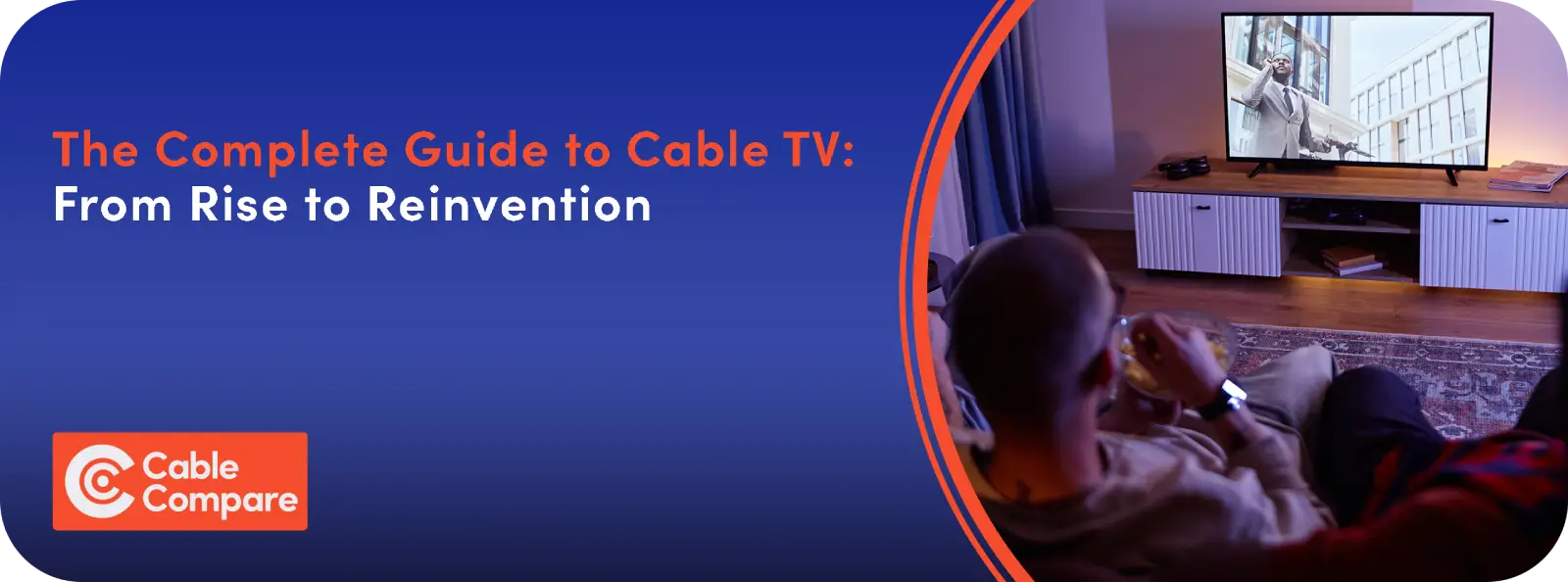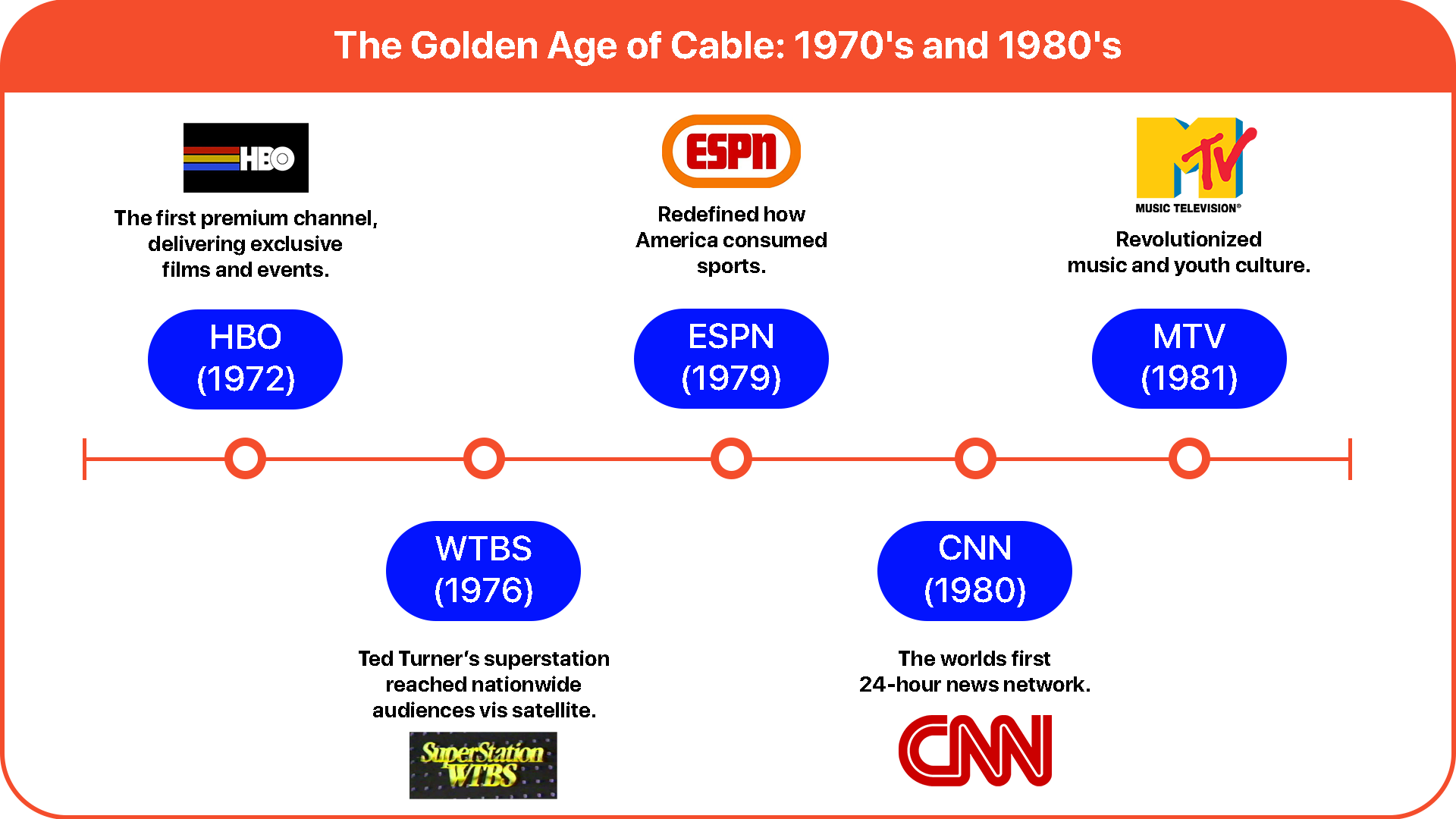Bryant Veney - Copywriter, CableCompare
Date Modified: December 15, 2025

Cable TV delivers television programming through coaxial or fiber-optic cables connected directly to your home. It offers live channels, on-demand content, and is often bundled with internet and phone services. However, the rise of streaming has reshaped how millions of people watch television today.
Cable television delivers TV programming through coaxial or fiber-optic cables instead of over-the-air signals. It emerged in the late 1940s in remote U.S. areas like Oregon and Pennsylvania, where mountains blocked OTA reception. Local entrepreneurs installed mountaintop antennas to capture signals and ran cables down to homes, creating the first cable systems.
The challenge was technical: amplifying distant signals without quality loss. Innovators built stronger amplifiers and better shielding to protect the signal. This effort laid the foundation for modern cable technology.
Cable TV works by capturing television signals at a central hub, called a headend, and distributing them through a physical network to subscribers' homes. Here's a simple breakdown of the process:
Modern cable systems use fiber-optic technology for faster speeds and better reliability, especially for bundled internet services.
Cable providers offer a wide array of channels and content and vary by provider and package tier, but most include:
Cable providers typically offer tiered packages to suit the needs of their customers. Channel packages often fall into these tiers:
Some providers now integrate streaming apps like Netflix and Hulu directly into their set-top boxes.
Cable TV pricing varies based on your provider, location, and package selection, but starts around $25 per month.
Cable operators face high costs to acquire and deliver content and networks to their customers. Those expenses are usually passed on to the customer and appear on monthly bills per the following:
Many providers offer promotional rates for the first 12 months, after which prices increase. Bundling cable with internet and phone service often reduces the overall cost.
The U.S. cable market is dominated by Xfinity (Comcast) and Spectrum (Charter). Here are a few major cable operators:
| Provider | Coverage | Starting Price |
|---|---|---|
| Xfinity | 41 states | ~$50/month |
| Spectrum | 41 states | ~$50/month |
| Cox | 18 states | ~$56/month |
| Optimum | Northeast U.S. | ~$45/month |
| Mediacom | Midwest/South | ~$40/month |
EarthLink offers TV services in select markets, bundling cable or satellite TV with its high-speed internet plans that is ideal for households looking for simplified billing and customer support.
For detailed comparisons and local availability, check providers in your area through CableCompare.
Pros:
Cons:
Cable TV and streaming services both deliver entertainment, but they differ significantly in cost, flexibility, and content offerings.
While streaming offers flexibility and lower entry costs, hidden expenses—like the need for high-speed internet and multiple platform subscriptions—can blur the savings. Cable remains attractive for households that prioritize live sports, local news, and channel variety without relying on Wi-Fi.
| Feature | Cable TV | Streaming Services |
|---|---|---|
| Monthly Cost | $50–$150+ | $5–$20 per service |
| Live TV | ✅ Yes (standard) | ⚠️ Select services only |
| On-Demand | ✅ Yes | ✅ Yes |
| Sports & News | ✅ Extensive | ⚠️ Limited (unless paying for live TV streaming) |
| Contract | Often required | Month-to-month |
| Equipment | Set-top box/DVR rental | Use existing devices |
| Internet Dependency | ❌ No | ✅ Yes |
Learn more about the cost of cable worldwide.
By the early 1960s, more than 800 cable systems served 850,000 subscribers. An FCC freeze on new broadcast licenses (1948 to 1952) inadvertently pushed consumers toward cable. Initially, cable simply retransmitted broadcast channels.
In 1962, the Federal Communications Commission (FCC) introduced rules requiring cable companies to carry local channels, which slowed growth in major cities but couldn't stop the industry's momentum.
The 1970s and 1980s saw cable's golden age. Several iconic networks launched:
Thanks to satellite technology, cable networks could beam content nationally. Cable companies invested in fiber optics and amplifiers, enabling hundreds of channels and more reliable service.

The Cable Television Consumer Protection and Competition Act of 1992 froze prices and restored power to local governments. By the late 1990s, cable went digital. This transition allowed more channels, improved picture and sound, and interactive program guides. It also laid the groundwork for on-demand services and broadband internet.
Cord-cutting surged as broadband and streaming grew, with over 5 million households dropping cable in 2023. To stay relevant, cable providers now lean on streaming integrations and app-based TV.
Three major innovations transformed cable TV:
Enabled sharper image quality and hundreds of channels.
Boosted signal strength and made high-speed internet over cable possible.
Introduced DVR, video-on-demand, and interactive menus.
The future of cable TV will see continued innovation and hybridization to compete with streaming services. Future advancements will likely include:
Cable providers are adapting by integrating streaming services, offering flexible bundles, and leveraging their infrastructure to deliver high-speed internet. While traditional cable viewership is declining, the technology and networks built over decades continue to deliver content to millions of subscribers.
Cable TV’s value to you depends on your household's needs and viewing habits. Cable TV remains relevant for:
If you rarely watch live TV, prefer on-demand content, or want to reduce monthly bills, streaming services or live TV streaming platforms (like YouTube TV or Hulu + Live TV) may be better options.
For many, the ideal solution is a hybrid approach: high-speed internet from providers like EarthLink paired with select streaming subscriptions, and a cable subscription for live television.
Cable TV uses coaxial cables (copper core with insulation) or fiber-optic cables (glass strands transmitting light signals) to deliver programming from a central hub to your home.
Most cable providers require a set-top box or CableCARD to access channels. Some newer TVs support cable-ready features, but you'll still need a box for premium channels, DVR, and on-demand content.
Yes. Cable TV and internet are separate services, though providers often bundle them at discounted rates. You can subscribe to TV-only plans, but internet-only plans are increasingly common as more people cut the cord.
Cable TV delivers programming through physical cables, while satellite TV uses a dish to receive signals from orbiting satellites. Cable typically offers more consistent service, while satellite may be the only option in rural areas.
Cable costs include infrastructure maintenance, content licensing fees (especially for sports), equipment rentals, and regional taxes. Prices have risen as networks demand higher fees for programming rights.
Yes. Most cable providers offer TV Everywhere apps (like Xfinity Stream or Spectrum TV) that let you watch live and on-demand content on mobile devices, as long as you have an active cable subscription.
If you're under contract, you may face early termination fees. You'll also need to return equipment (set-top boxes, remotes, modems) to avoid additional charges. Switching to streaming or bundling with a different provider may save money.
Yes. Cable offers the most comprehensive access to sports channels (ESPN, FS1, regional networks) without requiring multiple streaming subscriptions. Live TV streaming services like YouTube TV are viable alternatives but may cost nearly as much.
Most cable providers offer triple-play bundles (TV + internet + phone) at discounted rates. EarthLink, for example, bundles high-speed internet with TV options in select markets, simplifying billing and support.
Use comparison tools like CableCompare to check availability, compare prices, and read reviews. Availability varies by location, so it's important to see what's offered in your specific ZIP code.
Cable television has evolved significantly since its origins as a solution for poor broadcast reception in rural areas. Today, it competes with streaming giants while still offering unique advantages—reliable live TV, extensive sports coverage, and bundled service options.
Whether cable TV is right for you depends on your viewing habits, budget, and priorities. If you value live programming and don't want to juggle multiple streaming subscriptions, cable may still be your best bet. If you're budget-conscious and primarily watch on-demand content, exploring streaming options makes sense. For households seeking the best of both worlds, consider pairing high-speed internet from EarthLink with select streaming services. This approach gives you flexibility, reliability, and control over your entertainment budget.